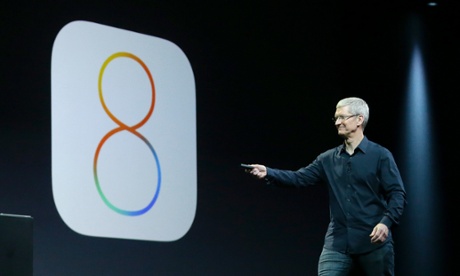Personalised connectivity, the next frontier for Apple
By Edwin Yapp June 6, 2014
- No new hardware announced; focused on healthcare, smart homes as new confines
- Still a way to go; privacy, security, interoperability and standardisation are challenges

On June 2, the Cupertino, California-based consumer electronics giant held its annual Worldwide Developers Conference (WWDC) at the Moscone Centre in downtown San Francisco, a yearly event that is highly anticipated by everyone in the tech world.
The expectations were high as the company usually announces a host of new hardware that normally comes to the market in the fall for the United States, including the new iPhone 6 and an anticipated wearable electronics piece dubbed the ‘iWatch.’
But surprisingly, none of that was announced this week.
As aptly summarised by CNET’s Roger Cheng: “Zilch. That's exactly what anyone tuning in to Apple's WWDC for any product announcements got on June 2. New MacBooks? Sorry. A new iPhone? Nope. That fabled iWatch? Please.”
But the executive editor of CNET was quick to clarify that this doesn’t mean that Apple did not make significant announcements that day. Cheng noted that true to its developer audience, the company chose to focus on its OS X Yosemite desktop operating system and iOS 8 mobile software.
Cheng followed up by giving his predictions for the coming months in which he concluded that Apple had its work cut out for the second half of the year.
For those interested, there is a detailed point-by-point look on what was announced at WWDC in this article by The Verge.
Nerve centre
 Behind the headlines of the two newly announced impending software upgrades were two specialised platforms – the HealthKit and HomeKit – which the company hopes to build on with its product announcements later in the year.
Behind the headlines of the two newly announced impending software upgrades were two specialised platforms – the HealthKit and HomeKit – which the company hopes to build on with its product announcements later in the year.
What struck me about these announcements, after reading a smorgasbord of analyses from various media and analyst firms, is the longer term vision that Tim Cook (pic) and his top lieutenants, Internet services chief Eddy Cue and software chief Craig Federighi articulated.
In a nutshell, I see Apple moving towards building an integrated platform for vendors and service providers to commune in a bid to continue its dominance in the consumer tech world and stave off competition in Google, Microsoft, Samsung and the rest.
Take for example, its HealthKit announcement, an interface where developers can build upon allowing both apps and Apple’s devices to monitor a person’s vitals.
According to Reuters, Apple’s HealthKit is able to pull together data such as blood pressure and weight now collected by a growing number of healthcare apps on the iPhone or iPad, and an app Apple dubbed ‘Health’ that will be an integral part of its operating system, iOS 8.
The company will reportedly work in tandem with Nike, a major player in fitness tracking, and the Mayo Clinic on the new feature, which will be included in the latest mobile software.
Ditto for the HomeKit, which is a set of tools that allows developers to make Apple’s products [iPhones and iPads] control home elements including everything from lights to all kinds of sensors and locking mechanisms in the home.
In my opinion, Apple is trying to lead the way in an increasingly fragmented world that intersects wearable electronics, health and wellness as well as the integrated home.
By getting in front of the queue before the others, Apple will not only be a thought and brand leader in this sector but it would also be able to set the specifications, standards and protocols for that frontier.
Jan Dawson, an analyst with Jackdaw Research, believes that these products promise to overcome the fragmentation currently in evidence in both these markets [wearable and smart home] with a plethora of devices that don’t talk to each other.
The former chief telecom analyst of Ovum says such a system will be able to bring together these devices by creating a single user interface to control various smart home devices on the one hand, and gather data from a variety of health devices on the other.
“The key thing with both concepts is that they’ll be most useful for people who have more than one such device, whether in the wearables or smart home category,” he said in a research note.
“If a Nest is the only smart home device you have, the Nest app is probably fine, and if you only have a Pebble smartwatch, the Pebble app is probably fine. But it’s when you start to make use of more than one such device that Apple’s HomeKit and HealthKit will spring into action.”
Some way to go
 While the potential of these announcements is immense, several factors are likely to influence their adoption rates.
While the potential of these announcements is immense, several factors are likely to influence their adoption rates.
The first that come to mind are security and privacy. With recent revelations of governments acting in Orwellian proportions by spying on their citizens and listening to their phone conversations, these issues aren’t going to go away and will likely be top of mind for consumers going forward.
Never mind the legislative hurdles that companies such as Apple and its kin are going to face with lawmakers. The whole issue will centre on the issue of trust, and whether consumers and customers would do exactly that with companies when it comes to such personal data.
This is especially true for Apple’s HealthKit, where it would need to persuade consumers to part with their vital health data in order to make the service work.
Secondly, because Apple has always controlled the end-to-end development of its products and services, it’s in the best position to pull such an initiative off.
But beyond developing the platforms such as HealthKit and HomeKit, they would need to extend their cooperation to third-party developers and end-user healthcare and smart home device makers.
This means opening up its ecosystem and getting third parties involved. And making such a service work would rely on more than just devices and software developers, and would include the larger healthcare fraternity, including healthcare providers, doctors and insurers.
It also means that Apple will have to deal with the ugly issues that have to do with standardisation and interoperability between devices and services, which in themselves are significant challenges.
Lastly, while these services sound sexy and great to have, I wonder how much of it can be contextualised in developing countries such as those in South-East Asia?
HealthKit may work well and good in the United States or Europe but will it work here where there are many more hurdles -- legislative, developmental and political -- to overcome in order to get the consumer and service providers on board?
After all, Apple is no longer just selling hardware and software, which is quite disconnected from society at large.
As it strives to become a company that aims to have greater impact on the wider society through new wares and services, these are but some questions that must be answered before such conveniences become a reality and on our radars.
Related Stories:
Apps: 268bil downloads, US$77bil in revenue by 2017, says Gartner
59% of APAC enterprises have ‘Internet of Things’ plans: Global IT body
TeAM to take on Apple in trademark issue, calls for evidence
For more technology news and the latest updates, follow us on Twitter, LinkedIn or Like us on Facebook.


